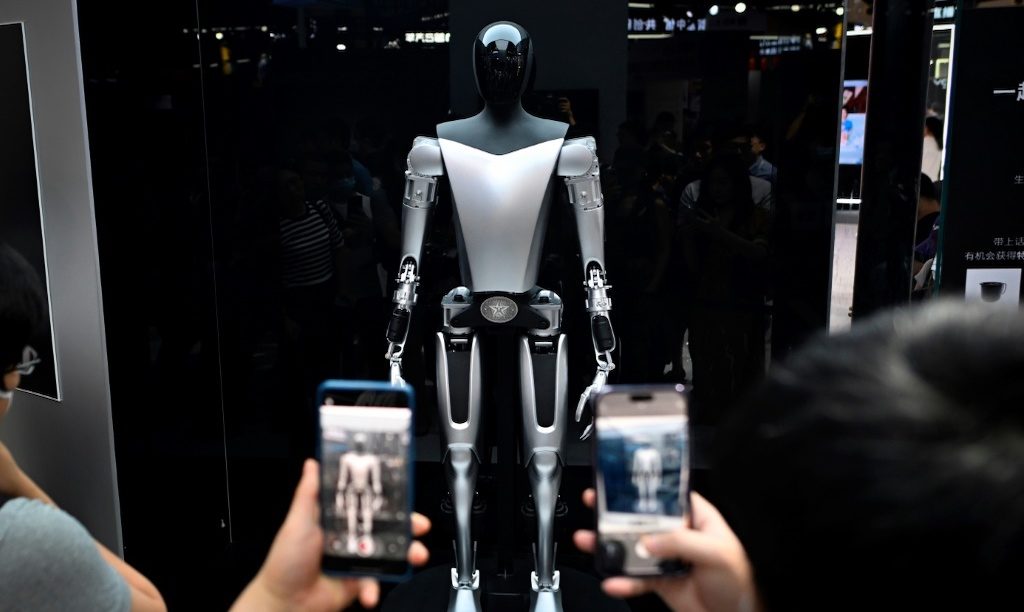Op-Ed: First generation deployable AI robots — Has Musk got it right?

Tesla’s Elon Musk is among those claiming that AI could make humanity extinct, while standing to benefit by arguing only their products can save us – © AFP/File WANG Zhao
For all the fuss about artificial intelligence and robotics in general, you’d think the news, hysteria and bafflement about AI robots would be a bit more specific. The Tesla bot Is an artificial intelligence robot which will be deployed in consumer markets very soon.
Called Optimus, this bot learns for itself, corrects its own errors, and if the demo videos are anything to go by it looks pretty efficient. No hysteria yet? Tesla is naturally hyping Optimus, but there are several truths in this hype.
The physiology of Optimus is exactly what you’d expect from a thorough upgrade of prior robotics technology. Agility is good. The robotic hands are very articulate. The overall look is clearly intended to be commercial and is a sort of pastiche of futuristic upmarket designs.
Optimus is pretty much the incarnation of a mix of expectations and practical technology as a market image. Artificial intelligent robots are inevitable.
There is nothing good to be said for a freestanding mobile robot which can’t learn and adapt to situations for itself. According to Tesla Optimus is all about machine learning. It’s unclear exactly how far this learning capacity can go, but it obviously goes far enough for the robot to operate independently to some level.
So far, so theoretically good. If you look at the “physique” of Optimus, It’ll notice that this is a fairly slim robot. That’s a weight-saving and weight-managing thing. It’s also good fundamental design because it reduces the physical stresses on the machine.
Other robots are all shapes and sizes, and certainly couldn’t be described as “agile”. Many of these robots are specialists for specific tasks. By comparison, Optimus is a bit of an athlete. This all-round design is obviously not a coincidence. The general idea is that Optimus will be an all-purpose functional robot in a range of different environments.
Optimus will be available for sales, lease or hire. That means the robots can be essentially a paid service which can be used at will. If that also sounds like good market positioning, it is. Tesla is also aiming at the investment market indicating very strong revenue from its AI with Optimus carrying the flag.
Not everyone’s happy about Optimus. The skepticism is having a hard time keeping up with the hype. Not everyone’s being negative about it either. That may be because it’s very hard to do a negative beat-up on something you know nothing about, but the technical commentaries seem pretty even-handed.
Then there’s Musk himself. For all his painfully awkward and downright clumsy moves on social media and in politics, let’s remember that this is Musk’s forte. This is what he’s actually good at. A bit of objectivity in the criticism would help.
A bit more attention to the actual imagery and hard sell would also be useful. What he’s done Is create a robot which is fully in line with human expectations of robots.
For the last 80 years, from Asimov onwards, there is an image of what robots should be and should look like. Optimus is exactly that. This is excellent market psychology. Competitors should take note of this fact because it does matter, and it matters a lot to market acceptance.
In effect this is the “acceptable” face of robotics 2024 style. It’s not a monster. It’s not some incomprehensible thing with another incomprehensible thing inside.
What are the commercial realities? There’s a bit of work to be done here. Optimus has to deliver functionality. It has to deliver measurable values. Above all it has to be cost effective. There’s a large mountain range to climb here for Tesla to deliver the kind of sales volume it obviously wants.
There are also basic commercial questions to be asked and answered:
What are the public liability issues?
How do you manage service requirements in an operational environment?
Is there a simple Off switch in case of malfunctions?
How do you manage procedural errors?
What about upgrades?
How does Optimus fit into an existing commercial environment?
Do you need to redesign your business to work with Optimus?
I would be prepared to guess that Tesla has at least some of the answers ready to go. Optimus doesn’t look half-baked, and nor do its promos. There has clearly been a lot of work behind the scenes to make Optimus market-ready.
One of the more futuristic proposals for Optimus is to use robots to colonize Mars. That’s nothing like a unique idea. A lot of people have been saying for years that it would be safer and more efficient to use robots on Mars.
Think about that idea for half a second and you will see the kind of functionality that is required to even suggest that your product is capable of doing that. For an independent AI-operated robot, it’s a big ask.
I think we can suspend judgment on the hype for now simply because the bar has been set so high. If Optimus works as intended this is a new horizon.
______________________________________________________________
Disclaimer
The opinions expressed in this Op-Ed are those of the author. They do not purport to reflect the opinions or views of the Digital Journal or its members.
Op-Ed: First generation deployable AI robots — Has Musk got it right?
#OpEd #generation #deployable #robots #Musk





